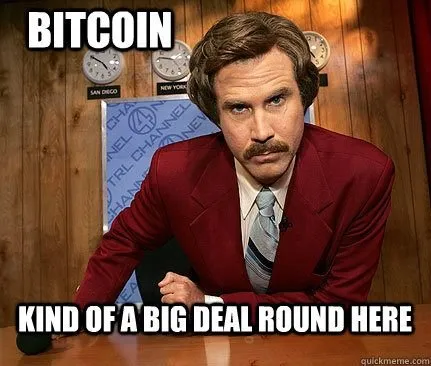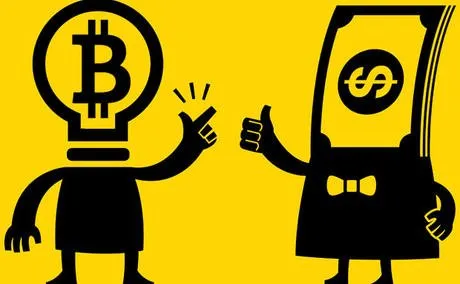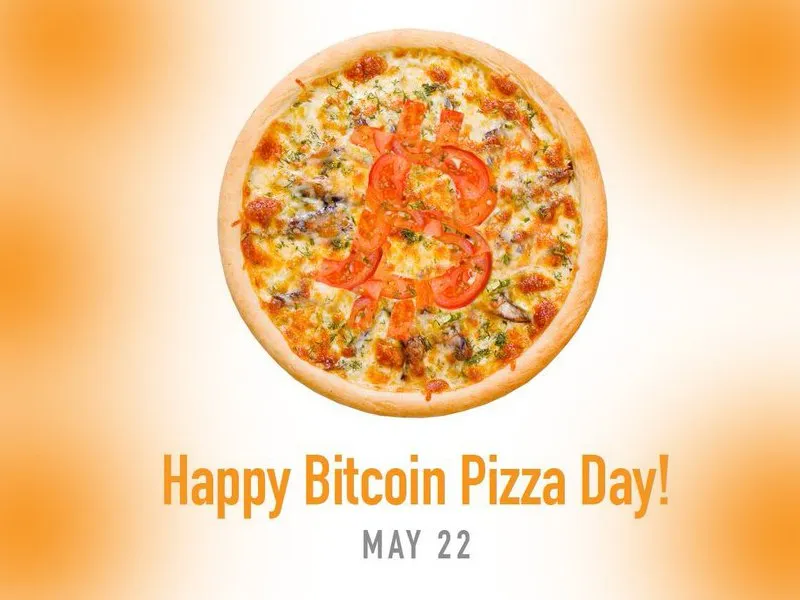Why Bitcoin Is Not Fiat

The dismissive statement, “Bitcoin is fiat,” or, “Bitcoin is just another fiat currency,” is becoming so common that it is annoying. I recently had the experience of having back-to-back independent conversations with two different people that gave me the exact same speech about Bitcoin being fiat, one on Facebook and one on Youtube. These were both otherwise intelligent people, but this is not an intelligent critique of Bitcoin.
It took a bit of work, but I was eventually able to get them both to acknowledge that Bitcoin is not fiat, and I did it via a condensed lesson on the History of Economic Value Theory. So because I know this argument is so common, and because I know the precise reasons why it is wrong, I’ve decided to settle this argument right here, right now, once and for all. Hopefully this will help you and others whenever and wherever this sophistic argument pops up in the wild:
fi·at
ˈfēət,ˈfēˌät/
noun : fiat; plural noun: fiats
1 a formal authorization or proposition; a decree.
2 arbitrary order.
The Claim: “Bitcoin is just another fiat currency.”
The Definition: A “fiat money” or “fiat currency” is a money that is only money because it has been declared to be money by official government decree or law.
The Refutation: Bitcoin is money without being declared to be money by an official government decree or law.
The Conclusion: Bitcoin is therefore not fiat.
Yes, refuting this all too common argument should really be that simple, but alas, the truth is that when people claim that Bitcoin is fiat, usually what they really mean is something very different than, “Bitcoin is money only by government decree.” Usually, instead, what they really mean to say is, “Bitcoin has no Intrinsic Value.”
Most people that say Bitcoin is a fiat currency are really trying to say that they don’t trust Bitcoin because it’s value is derived subjectively rather than intrinsically.
Their concern is that, since Bitcoin has no Intrinsic Value, it is therefore theoretically possible that all of Bitcoin’s value could disappear over night. All it would take is a collective loss of confidence - such a subjective and fickle thing - and Bitcoin would return to it’s Intrinsic Value: zero. Therefore, Bitcoin is essentially worthless in their eyes.
The types of people that make this argument tend to prefer precious metals like gold, which they perceive as having Intrinsic Value as a result of it’s utility as an industrial metal. They rest on the fact that even if all speculative value in gold as a Store of Value and Medium of Exchange were to disappear tomorrow, it would at the very least, still have value based on the demand for gold for use in circuit boards, jewelry and other industry needs.
What those who make this argument don’t know is that they are arguing from an Economic Value Theory that has been conclusively discredited for over one hundred years now.
The Intrinsic Theory of Value, also known as the Objective Theory of Value, holds that the value of an object, good or service is intrinsic, or contained in the item itself. This Theory of Value was the orthodox view in Economic Thought for a very long time, but it turned out that this view gives rise to a seemingly unresolvable paradox.
It seems to always be the case, whether in science, philosophy, or economics, that the first hint that your underlying foundational assumption may be incorrect, is that holding to your foundational assumption results in the inability to resolve some persistent paradox within your world view.
The Intrinsic Theory of Value gave rise to The Paradox of Value, which it could not resolve.
Water, is perhaps the clearest example (pun intended) of a commodity which can be said to have Intrinsic Value, because it is a commodity which is essential to life. Like oxygen or food, water is an example of something that is valued because of it’s intrinsic properties and intrinsic power to support life.
The Paradox of Value arrises when comparing something like water with something like diamonds. Water is on the whole much more valuable, in terms of survival, than diamonds, yet diamonds command a much higher price on the market. If you compare the price of a pound of water with the price of a pound of diamonds, it would seem that diamonds have much more “Intrinsic Value” than water, yet we know this to be untrue empirically.
Furthermore, if the value of thing is Objectively Intrinsic to the thing itself, why then does value fluctuate depending on circumstance? If the value of an object is intrinsic and objective, than the value of that object should remain the same regardless of circumstance, as long as the intrinsic properties of the thing remain the same. Yet we know that in the circumstance of a man lost in the desert and dying of thirst, if he were carrying a backpack full of diamonds and happened upon a man with a gallon of fresh water, he would be willing to sell his backpack full of diamonds for the gallon of water.
This Paradox of Value is also known as the Diamond-Water Paradox, articulated beautifully by Adam Smith who said:
“The word Value, it is to be observed, has two different meanings, and sometimes expresses the utility of some particular object, and sometimes the power of purchasing other goods which the possession of that object conveys. The one may be called, “value in use,” the other “value in exchange.” The things which have the greatest value in use have frequently little or no value in exchange; and, on the contrary, those which have the greatest value in exchange have frequently little or no value in use. Nothing is more useful than water; but it will purchase scarce anything; scarce anything can be had in exchange for it. A diamond, on the contrary, has scarce any value in use, but a very great quantity of goods may be had in exchange for it.”
According to Adam Smith’s distinctions of “Value In Use” and “Value In Exchange” the argument that, “Bitcoin is fiat,” could also be retooled as, “Bitcoin is all Value In Exchange, and zero Value in Use,” which I will show too is incorrect.
Intrinsic Theory of Value does not provide an explanation for why diamonds are more valuable than water on the market place. If the value is intrinsic to the properties of the thing itself, then one cup of water should be just as valuable in a desert as it is in a rain forest, and one diamond, having virtually zero utility in terms of survival and sustaining life, should be worth much less then one cup of water both in deserts and in rainforests. The fact that none of this is the case, that in reality a diamond is worth much more than a cup of water, and a cup of water is worth much more in a desert than in a rainforest, leads to this paradox.

Like any paradox, the way to resolve it is to question and rethink the underlying fundamental assumption, which is in this case the Intrinsic Theory of Value. It turns out that the solution to this paradox is abandoning Intrinsic Theory of Value for the Subjective Theory of Value, and with the genius of one Carl Menger, the field of Economics did just that in the late 19th century, giving rise to the emergence of Marginalism.
The Subjective Theory of Value advances the idea that the value of an object, good or service is not determined by any inherent property of the object, good or service, nor by the amount of labor necessary to produce the object, good or service, but instead, **value is determined by the importance an acting individual places on an object, good or service for the achievement of his or her desired ends. **
When I purchase a veggie burger for $10, it is not because the value of the intrinsic properties of the veggie burger are objectively equal to the value of the intrinsic properties of $10, but rather, it is because I subjectively value the veggie burger more than I subjectively value $10 in satisfying my want for a tasty meal. And whoever is selling the veggie burger is willing to part with it in exchange for ten Federal Reserve notes, because he subjectively values $10 more than he subjectively values the veggie burger in satisfying his desired ends or in satisfying his particular wants. It could be, for instance, that his belly is full but he needs $10 worth of gasoline, his marginal utility for $10 would then be much more than his Marginal Utility for the burger in satisfying his need for gasoline.
The Theory of Marginal Utility emerges out of the Subjective Theory of Value, which says that the value of an object, good or service is derived from it’s most important use to a person. So if a person possesses a good, he will use it to satisfy some need or want, and the need or want he will use it to satisfy will be the one that takes highest priority in his personal subjective scale of most important to least important needs and wants. As these more important needs and wants are satisfied by the object, good or service, additional units become less and less valuable, because they will be used for less and less important needs and wants.
The classic illustration provided by Carl Menger is the example of a farmer with 5 sacks of grain.
Let’s say the farmer has labelled the bags of grain #1, #2, #3, #4, and #5:
- With the first, he will make bread to survive; survival being his most important desired end on his subjective scale.
- With the second, he will make more bread; not just to survive, but in order to be strong enough to work, which is his second most desired end.
- With the next he will feed his farm animals so that they will produce for him eggs, and milk and various other productive things, which is his third most desired end.
- The next is used to make whisky, which he gets great pleasure from on holidays, special occasions, and after a hard days work on the farm and contributes to his morale, his fourth most desired end.
- And the last one is used to feed pigeons, which he enjoys doing on Sundays, and gives him the feeling of connection with nature, his fifth most desired end.
Now, if bag #3 is stolen by a wild fox, what will the farmer do? Since bag #3 was designated for his farm animals will he now be forced to stop feeding them? Will his farm animals starve to death as a result?
Of course not. The answer is: he will no longer be feeding the pigeons on Sundays as a result of the loss of one bag of grain, because feeding pigeons was the least important desired end on his subjective scale of value. He will not eat less bread, feed his animals less food, or make less whisky, instead he will just stop feeding the pigeons.
So the value of the fifth bag of grain is equal to the satisfaction he gets from feeding pigeons. If that bag is gone, the value of the fourth bag is equal to the value of the satisfaction he gets from drinking whisky. If that bag is gone, the third bag is equal to the value of the satisfaction he gets from feeding his farm animals. And if that bag is gone, the second bag is equal to the satisfaction he gets from eating enough to be strong enough to work on the farm. Only if he loses four bags will he himself start eating less, and the value of the last bag of grain is worth his very life.
The Subjective Theory of Value and the Theory of Marginal Utility shows us how five identical bags of grain, with identical intrinsic properties, can very greatly in their value.
In explaining the Diamond-Water Paradox, it is true that the total utility of water to people is tremendous, because we need it to survive. However, since water is in such large supply in the world, the marginal utility of water is very low because each additional unit of water that becomes available can be applied to less and less urgent uses as the more urgent uses for water have already been satisfied.
Water becomes less valuable to people as the supply of water increases, and this is also true of diamonds, but the supply of diamonds is extremely low. So low that the usefulness of one additional diamond as far as satisfying your desired ends for diamonds is very great, whereas the usefulness of one additional cup of water, which is in abundant supply, as far as satisfying your desired ends for water is very low.
Thus, the Subjective Theory of Value resolves the Diamond-Water Paradox by showing why those who want diamonds are willing to pay a higher price for one diamond than for one glass of water. And at the same time, it also explains why a man dying of thirst in a desert would be willing to sell a sack full of diamonds for a single cup of water.
One begins to see that the centre of value is within us, not in the thing itself.
The Intrinsic Theory of Value simply does not hold water. (Proof that the Law of Diminishing Marginal Utility applies even to puns) Value is not in fact derived from any inherent property of the thing itself, but instead it is derived by the importance we subjectively place on the thing for achieving desired ends on our subjective scales of importance.
Further, it shows that the element of scarcity seems to have a share in all estimates of value. The difference between bare utility and value is quantitative. Variations in the immediate supply of a thing greatly effect our subjective valuations because it effects our ability to utilize the thing to satisfy our most urgent needs to our least urgent.
Bitcoin does not have Intrinsic Value, because NOTHING has Intrinsic Value. Things have intrinsic properties, but all value is derived subjectively.
Bitcoin has acquired value subjectively because many people have placed importance on it for achieving some desired end. And also, the supply of Bitcoin is limited, only 21 million Bitcoins will ever exist in the world. Thus, like diamonds, the supply is low, and the value is high. If Bitcoins were abundant, the value would be very low. If they were infinite, the value would be zero.
Once a thing has gained value via the subjective valuation of an individual or group of individuals that have placed some amount of importance on that thing for the achievement of one or more desired ends, it can become a Store of Value only if it is scarce, otherwise it’s value disappears via the Law of Diminishing Marginal Utility, as is the case with water.

Bitcoin gained value on May 22nd, 2010 when a programmer named Laszlo paid a fellow Bitcoin Talk Forum user 10,000 Bitcoins for two Papa John’s pizzas. Laszlo subjectively valued two large pizzas more than he valued the 10,000 Bitcoins, and the forum user subjectively valued the 10,000 Bitcoins more than he valued the two large pizzas he purchased from Papa Johns for $25. So at that moment, 10,000 Bitcoins was equal to $25, and one Bitcoin was worth $0.0025.
Once Bitcoin had gained a subjective value, because of Bitcoin’s perfect scarcity and perfectly limited supply, it is able to Store the Value it has.
Further, as demand for Bitcoin gradually increases over time, and as the constant supply of new Bitcoins into the market gradually decreases over time, according to The Law of Supply and Demand, the value of Bitcoin over time must go up.
It is also important to note that, if gold is perceived as having “Intrinsic Value” because of it’s utility as an industrial metal, a “Use Value” that would persist even in the absence of it’s, “Exchange Value” as a Medium of Exchange and Store of Value, then Bitcoin too could be argued to have “Intrinsic Value,” because even if all of it’s “Exchange Value” as a Medium of Exchange and Store of Value were to disappear overnight, Bitcoin would still have “Use Value” as an immutable-universal-publicly-verifiable ledger, and also as a secure way to quickly transfer value over communications channels.

One example of, “Use Value,” that Bitcoin offers is currently the ability to perform cheap and fast remittance services like the services offered by companies like Western Union. An immigrant who wants to send money from The United States back to his home country in Africa for example, is able to convert USD into Bitcoin, send the Bitcoin to his family in Africa instantly and virtually for free, and then quickly convert the Bitcoin into the local currency. This “Use Value” depends in no way on the price of Bitcoin, or Value Storage capacity of Bitcoin, or Medium of Exchange function of Bitcoin, it merely takes advantage of Bitcoin’s capacity to securely transfer value over communications channels. This function and use would persist even if all of the monetary value of Bitcoin disappeared overnight, just like gold’s use as an industrial metal would persist if the same happened to gold.
So to say that Bitcoin is a Fiat Currency, is at once to falsely assume that Bitcoin is all “Exchange Value” and zero “Use Value” as well as to regress to, and argue from the long discredited Intrinsic Theory of Value despite it’s being abandoned as a conclusively false Theory of Value over 100 years ago.
Not only that, but the actual definition of the word, “fiat,” has nothing to do with Intrinsic Theory of Value or Use Value versus Exchange Value anyway. The word, “fiat,” refers to a government order or official decree, but if the definition of “fiat” is modified to mean, “lacking intrinsic value,” or, “purely subjectively valued,” then we can admit that the statement, “Bitcoin is fiat,” becomes true. With one small caveat: so does the statement, “Everything that has value is fiat,” because literally nothing has intrinsic value. Anything that has value, has derived it’s value purely subjectively.
Follow Me for more Philosophy, Economics, Bitcoin, Cryptocurrencies, and Politics!
#bitcoin
#money
#cryptocurrency
#fiatcurrency
#intrinsicvalue
#gold
#silver
#value